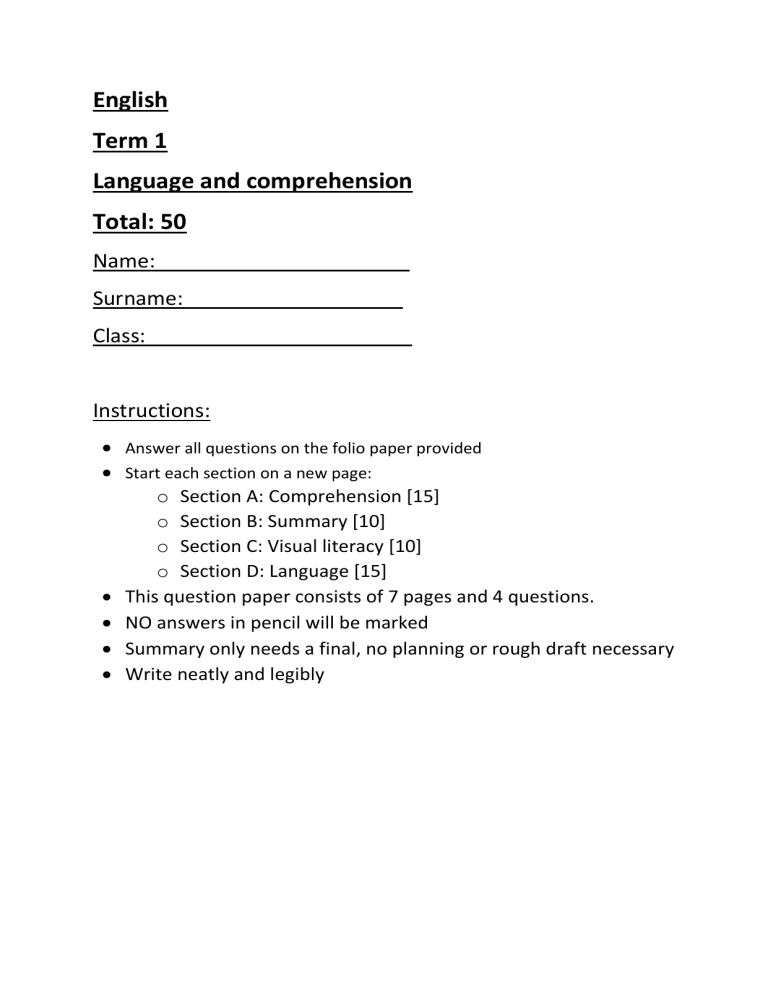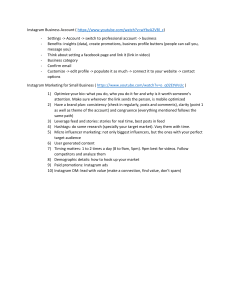
English Term 1 Language and comprehension Total: 50 Name:______________________ Surname:___________________ Class:_______________________ Instructions: Answer all questions on the folio paper provided Start each section on a new page: o Section A: Comprehension [15] o Section B: Summary [10] o Section C: Visual literacy [10] o Section D: Language [15] This question paper consists of 7 pages and 4 questions. NO answers in pencil will be marked Summary only needs a final, no planning or rough draft necessary Write neatly and legibly Section A: Coprehension [15] Selfie-Esteem: The Relationship Between Body Dissatisfaction and Social Media in Adolescent and Young Women written by Bindal Makwana, Yaeeun Lee, Susannah Parkin & Leland Farmer edited by Eiko Fried Social media platforms like Instagram and Facebook have become ingrained in the lives of countless individuals. With adolescents and young adults, particularly young women, being the primary users of such platforms. “Social media is not real life,” stated Essena O’Neill, a 19-year-old Australian Internet star who quit social media in November of 2015 to prove the point that social media is just a means of fake self-promotion. Essena was a star on Instagram, Tumblr, YouTube, and other social media platforms, with over 600,000 followers on Instagram alone. As soon as she went silent, her fans and friends created an uproar. They called the Australian teen out and accused her of intentionally closing her social media accounts in an attempt to attract more fame and attention. Her fans, friends, and followers began posting blogs and videos in reaction to Essena quitting social media, with some going so far as sending death threats. The same week Essena quit Instagram, The Guardian’s Mahita Gajanan asked other young women about their self-esteem and experiences with social media. Her findings were in line with Essena’s; most of the women that were interviewed felt insecure. Many young women reported obsessing over the number of “likes” they were getting, feared not looking beautiful in their photos, thought individuals would think they looked different on social media than in real life, and questioned what aspects of their life people would get a glimpse of. It was a common theme that women were dedicating extensive amounts of time to thinking about what image to upload, photoshopping it and regularly checking their personal page to see the updated “like” counts, which in turn increased their own insecurities. Even though many women were aware of these actions, they were consumed by their need to fit in on social media and struggled to disrupt their habits. Numerous young women reported that they lived their lives via social media and regarded media presence as more important than real life. This preoccupation with social media and the compulsive behaviors that follow may potentially contribute to body dissatisfaction. However, to this day, research findings have been mixed, and the exact relationship between social media behavior and body dissatisfaction is unclear. Extracted from www.in-mind.org Question 1 1.1. 1.2. 1.3. What does the title of this news article tell us about it. By who was this article written and edited. Quote a sentence from the passage stating the opinion of Essena O’Neill on social media. 1.4. What did Mahita Gajanan do. 1.5. Quote a part of the passage that proves people experience anxiety regarding social media posts. 2. Give the root word for the following: 2.1. Dissatisfaction. 2.2. Photoshopping 2.3. Insecurities 2.4. Preoccupation 2.5. Relationship (1) (2) (2) (1) (4) (5) Section B: Summary [10] Question 2 2.1. Summerise the following passage, in your own words, in 7 points detailing the precautions one can take to stay safe while browsing social media. Keep the summary between 100 and 120 words. Staying safe on social media Set your profiles to private. Think carefully about what you post online and who you want to see it. Consider setting your profiles to friends and followers only. Remember anything you post can be shared. Even with strong privacy settings in place, it is important that you remember that what you post online is never really private and can be shared. Posts also stay around on the internet long into the future. It is therefore important that you always think before you post. Switch off your location. Ensure only the people you trust know where you are! Recognise the fakes. Not everyone on social media will be who they say they are. There can be young people and adults who pretend to be someone else and could cause you harm. For example, they may want to trick you into sharing private or personal information that they could use against you. It's important that you never meet up with someone you don't know, and that you always let an adult know where you are going and who you are meeting. There have been times when children have been tricked into meeting adults who then cause them harm. Spring clean your contacts. Once you make a friend online, it doesn't have to be permanent. Regularly review and clean up your contacts - particularly anyone who spreads negative content or doesn't make you feel good about yourself. Block anyone who bothers you. All social media sites allow you to block people who you don't want accessing your account. It is not permanent and they won't be notified. You may also have the option of muting someone so they don't know you can no longer see their posts. Protect your identity, your phone number, address, bank details and any information that may hint to your personal passwords should never be shared online. Experienced password hackers or phishing sites can piece together your information to gain access to your account, or use your identity to create a new one. Make sure passwords are strong, change them regularly and always keep them private. Let your friends and family know about your online choices. Other people will never respect your privacy as much as you do. Make sure your friends and family know your preferences about uploading pictures, tagging your location or sharing information you expect to be confidential. This works both ways, so make sure that you respect other people's privacy in the same way. Watch out for suspicious messages with a shortened URL alongside a statement such as 'OMG look at this picture of you…' or 'Have you seen what they are saying about you…' are not to be trusted. Phishing emails are also a problem. These are fake communications pretending to be a trusted organisation such as Facebook that will try and get you to log in. They can look very convincing, and even have your personal profile info, so only sign into a site through their official page or app. If something looks suspicious, check the email address and put it through a search engine. Malicious senders are usually named and shamed online! Section C: Visual literacy [10] Question 3 3. Study the image below and answer the questions that follow. Source A 3.1. 3.2. 3.3. 3.4. What type of sentence is used in this image. Write out the word “we’re”. What are these people doing. Why do they all look so negative. (2) (2) (1) (2) How can we see that this event is upsetting to him. (3) Source B 3.5. Section D: Language [15] Question 4 4.1. Give the nouns, pronouns and proper nouns in the following passage. (5) Edward Ndopu spent his life in a wheelchair because he suffers from a disease that makes it impossible to walk. He was only a schoolboy himself when he began giving seminars to other disabled children. 4.2. Give an example of an adverbial clause. (1) 4.3. Rewrite the following sentences in the past tense. 4.3.1 The creatures of the forest live in harmony. (1) 4.3.2 The hummingbird scoops up a drop of water in her beak. (1) 4.4 Rewrite the following sentences in the future tense. 4.4.1 The fish was still alive in its bowl this morning. (1) 4.4.2 The boy is playing with his dog. (1) 4.5 Copy down the following passage and fill in the missing punctuation. _Wow_ She has so many followers on Instagram_Twitter and Youtube_how do you think she did it_ _ END (5)


